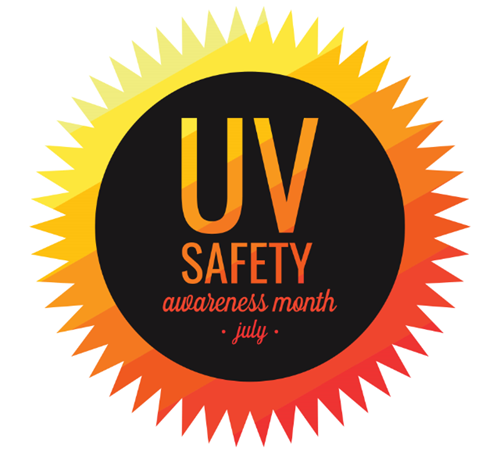
Summer is here and along with it, more sunshine filled days! It is important when you are out and about to practice Ultraviolet (UV) radiation safety. During this time of year, UV rays are very powerful and it is a good idea to take steps to protect yourself when possible.
The Centers for Disease Control and Prevention (CDC) has provided resources on how to stay safe when exposed to damaging levels of UV radiation. Check out some of their recommendations below.
- Seek shade - You can reduce your risk of skin damage and skin cancer by seeking shade under an umbrella, tree, or other shelter before you need relief from the sun.
- Wear protective clothing - When possible, long-sleeved shirts and long pants and skirts can provide protection from UV rays.
- Hats help - For the most protection, wear a hat with a brim all the way around that shades your face, ears, and the back of your neck.
- Use sunglasses to protect your eyes – Sunglasses can help reduce the risk of cataracts. They also protect the tender skin around your eyes from sun exposure. Sunglasses that block both UVA and UVB rays offer the best protection.
- Put on broad-spectrum sunscreen - Use sunscreens with SPF 15 or higher before you go outside, even on slightly cloudy or cool days. Sunscreen works best when combined with other options to prevent UV damage.
More about Sunscreen
Sunscreen combined with other safety measures is a good way to protect yourself from UV radiation. Read below to see what the CDC says about the use of sunscreen.
- Sunscreens are assigned a sun protection factor (SPF) number that rates their effectiveness in blocking UV rays. Higher numbers indicate more protection. You should use a broad spectrum sunscreen with SPF 15 or higher.
- Reapplication is important. Sunscreen wears off. Put it on again if you stay out in the sun for more than two hours and after swimming, sweating, or toweling off.
- Check the sunscreen’s expiration date. Sunscreen without an expiration date has a shelf life of no more than three years, but its shelf life is shorter if it has been exposed to high temperatures.
Who is at risk?
According to the CDC, anyone can get skin cancer, but is more common in people who:
- Spend a lot of time in the sun or have been sunburned.
- Have light-color skin, hair, and eyes.
- Have a family member with skin cancer.
- Are over age 50.
Children and the Sun
Sunburns when you are young can cause complications down the road. It is important to protect children from UV rays whenever they are outdoors. Learn more about sun safety for children.
UV Index
The CDC recommends referring to the U.S. Environmental Protection Agency’s UV Index external icon. It shows UV levels and you can find the specific index for your area. Keeping in the know about your area’s UV index, and taking necessary precautions, can help you and your loved ones stay safe this summer!
CCHA is here to help!
Our care coordinators can help you connect with a provider, assess your needs and help you gain access to resources to support you and your family’s health.
Call CCHA Member Support Services
303-256-1717 | 719-598-1540 | 1-855-627-4685 (TTY 711)
Monday through Friday, 8 a.m. to 5 p.m.